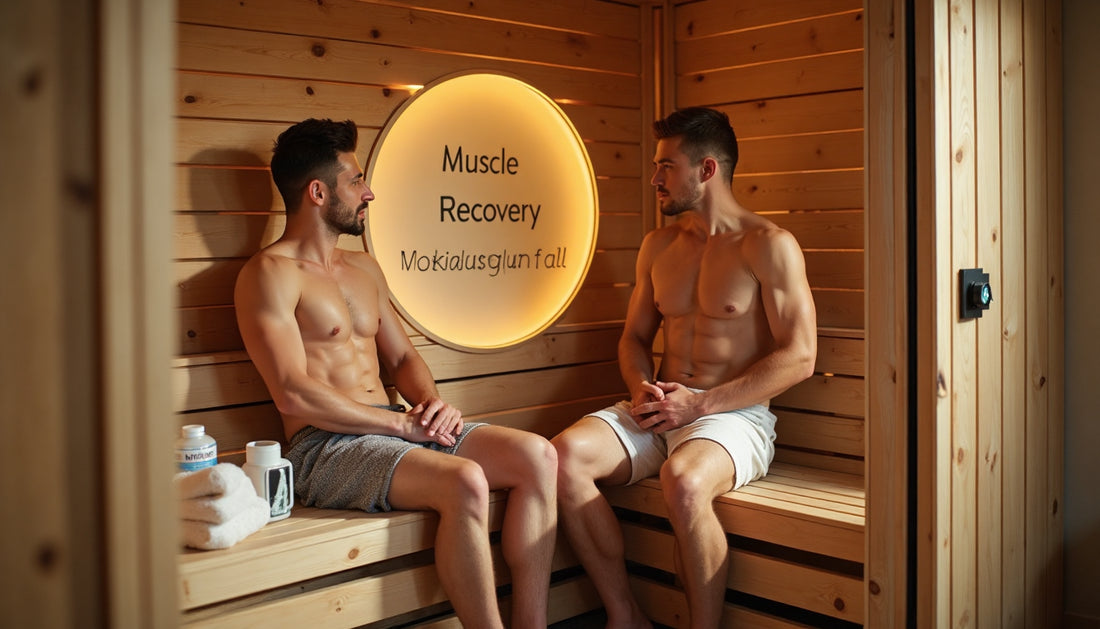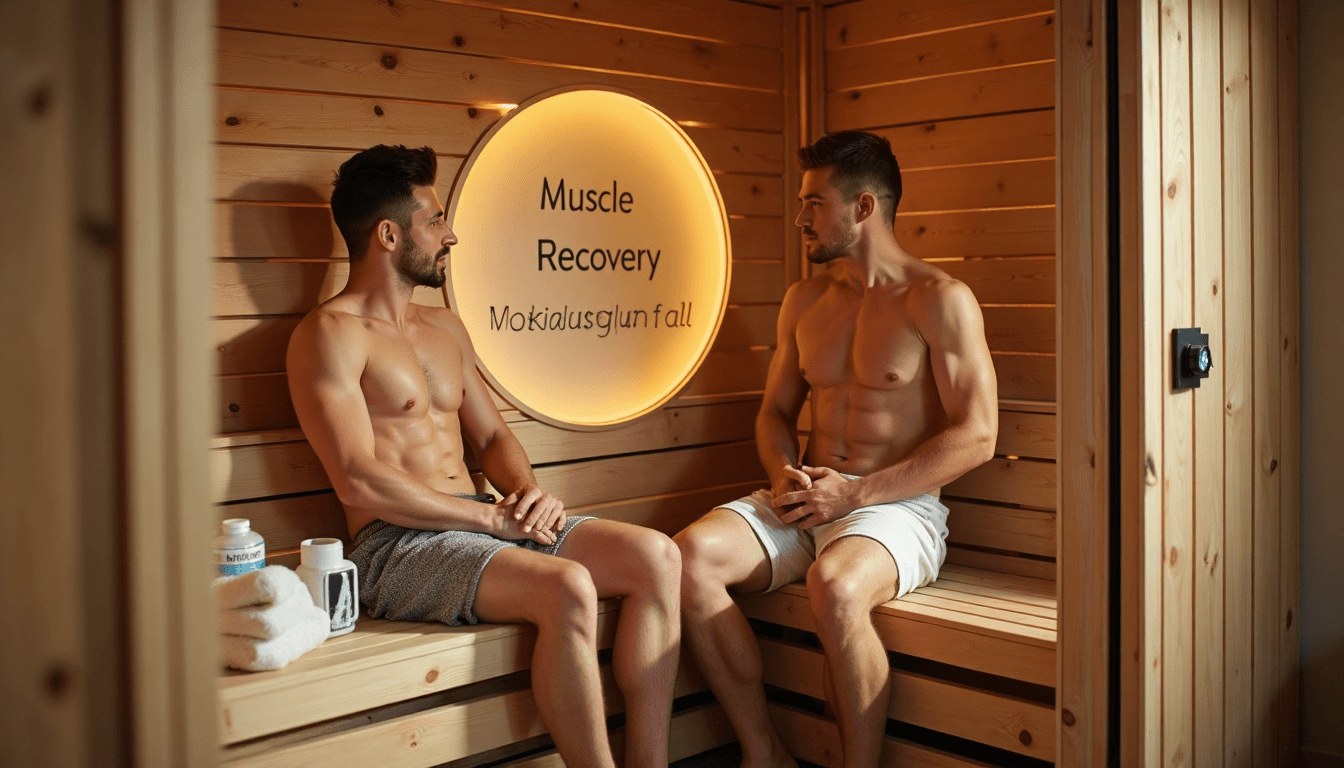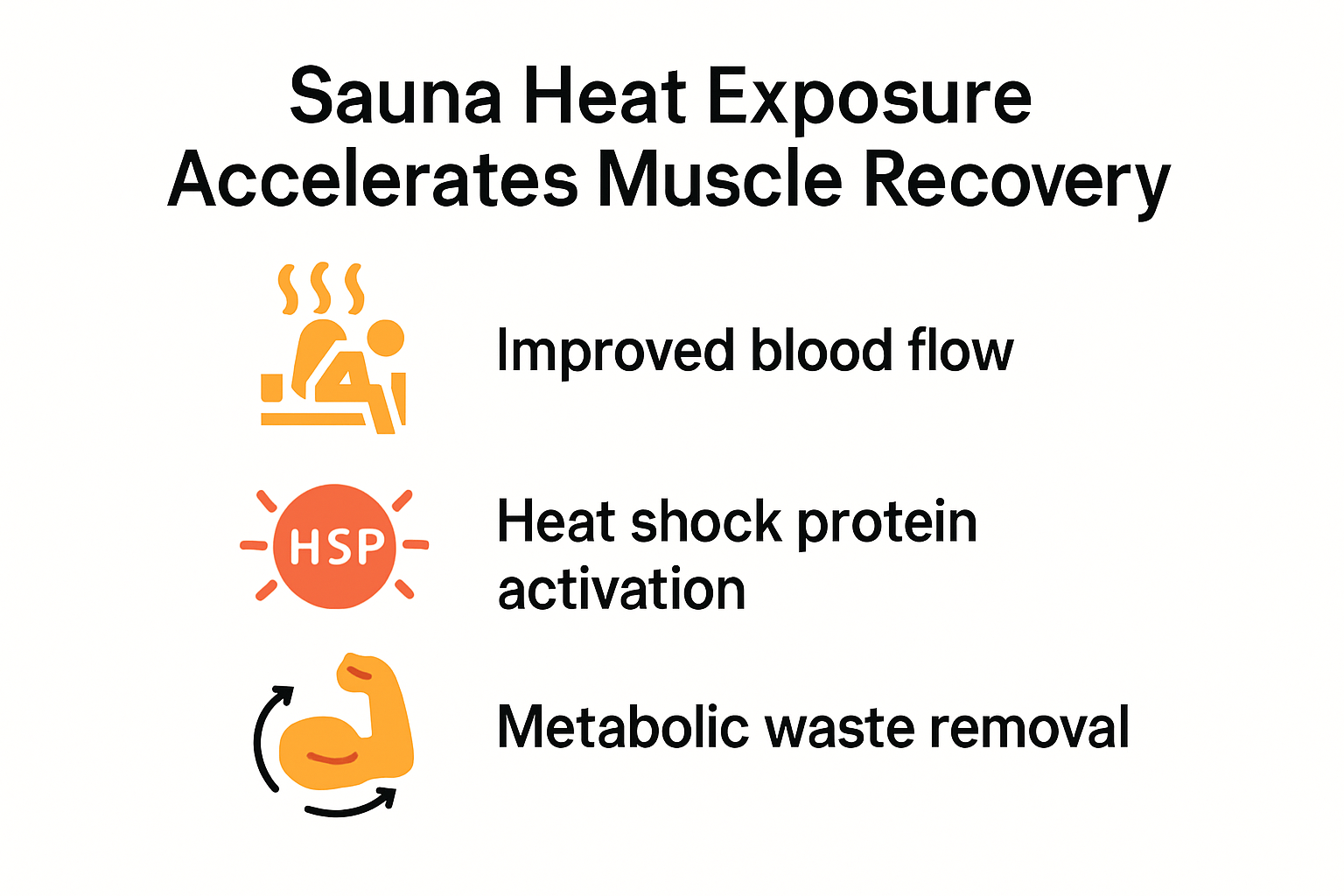
Sauna for Muscle Recovery: Benefits and Best Practices 2025

Muscle soreness after a tough workout can linger for days, leaving even dedicated athletes searching for faster relief. Here is something wild: a single 30-minute infrared sauna session has been shown to reduce post-exercise muscle soreness and improve neuromuscular performance. It sounds like stepping into a sauna is just about sweating out fatigue. Actually, the real magic happens at the cellular level, where heat triggers powerful healing responses your muscles desperately need.
Table of Contents
- How Sauna Supports Muscle Recovery
- Top Benefits Of Using Sauna After Exercise
- Best Sauna Practices For Maximum Muscle Relief
- Choosing The Right Sauna For Home Wellness
Quick Summary
| Takeaway | Explanation |
|---|---|
| Saunas enhance muscle recovery | Sauna use accelerates muscle healing by increasing blood circulation, reducing muscle soreness, and improving nutrient delivery to damaged tissues. |
| Frequency and timing matter | Optimal sauna sessions should be 2-3 times per week for 15-20 minutes, ideally post-workout to maximize recovery benefits. |
| Incorporate complementary recovery strategies | Combine sauna use with other recovery methods like gentle stretching and proper hydration to optimize muscle restoration. |
| Choose the right sauna for your needs | Consider infrared vs. traditional saunas based on personal comfort and health goals, and evaluate installation and space requirements carefully. |
| Listen to your body | Pay attention to personal physical responses during sauna sessions and consult healthcare professionals if you have pre-existing health conditions. |
How Sauna Supports Muscle Recovery
Muscle recovery represents a critical process for athletes, fitness enthusiasts, and individuals engaged in physical training. Saunas offer a powerful, scientifically supported method to enhance this recovery through multiple physiological mechanisms that help repair and rejuvenate muscle tissue.

Thermal Stress and Muscle Healing
When muscles experience intense physical activity, they undergo microscopic damage that requires strategic recovery. Sauna heat exposure triggers a remarkable biological response that accelerates healing. Research published in PubMed revealed that applying sauna heat before eccentric exercise significantly reduced deficits in muscle strength and range of motion. The controlled heat stress stimulates heat shock proteins, which play a crucial role in cellular repair and protection.
The thermal stress generated in a sauna environment creates a controlled inflammatory response that enhances blood circulation. This increased blood flow delivers essential nutrients and oxygen to damaged muscle tissues, facilitating faster recovery. Improved circulation helps remove metabolic waste products that accumulate during intense physical activity, reducing muscle soreness and promoting quicker healing.
Hormonal and Physiological Adaptations
The heat stress induces the release of human growth hormone, which plays a significant role in muscle tissue repair and regeneration. Additionally, sauna sessions stimulate the production of norepinephrine, a hormone that supports muscle protein synthesis and reduces inflammation. These hormonal responses create an optimal internal environment for muscle recovery and potential growth.
Sauna sessions trigger a complex cascade of hormonal and physiological changes that support muscle recovery. A fascinating study from MDPI observed that 12 sessions of high-temperature sauna baths led to an increase in muscle mass among healthy young men. This suggests that repeated sauna exposure might promote muscle hypertrophy beyond traditional recovery mechanisms.
The heat stress induces the release of human growth hormone, which plays a significant role in muscle tissue repair and regeneration. Additionally, sauna sessions stimulate the production of norepinephrine, a hormone that supports muscle protein synthesis and reduces inflammation. These hormonal responses create an optimal internal environment for muscle recovery and potential growth.
Neurological and Metabolic Benefits
Beyond direct muscular healing, sauna use impacts the neurological and metabolic systems that support overall recovery. The intense heat exposure challenges the body’s thermoregulatory system, creating adaptive responses that enhance overall physiological resilience. This process, known as hormesis, strengthens the body’s ability to manage stress and recover more efficiently.
Metabolically, sauna sessions increase mitochondrial efficiency, the cellular powerhouses responsible for energy production. Improved mitochondrial function means muscles can regenerate and rebuild more effectively. The heat-induced stress also activates metabolic pathways that support cellular repair and reduce oxidative stress, further supporting comprehensive muscle recovery.
While sauna use presents remarkable benefits for muscle recovery, individuals should approach it strategically. Proper hydration, moderate session duration, and listening to one’s body remain crucial for maximizing these physiological advantages. Consultation with healthcare professionals can help develop a personalized sauna recovery strategy tailored to individual fitness goals and physical conditions.
Top Benefits of Using Sauna After Exercise
Post-exercise sauna sessions offer a comprehensive approach to enhancing physical recovery and overall wellness. Athletes and fitness enthusiasts are increasingly recognizing the transformative potential of integrating sauna therapy into their post-workout routines, leveraging its multifaceted physiological benefits.
Accelerated Muscle Recovery and Performance Restoration
Research from Verywellhealth indicates that sauna use dramatically improves muscle recovery by increasing blood circulation and delivering critical oxygen and nutrients to fatigued muscle groups. A compelling study published in the National Institutes of Health demonstrated that a 30-minute infrared sauna session after endurance exercise significantly reduced post-workout muscle soreness and improved neuromuscular performance.

The controlled heat environment stimulates a profound healing response, helping muscles repair micro-damage sustained during intense physical activity. By promoting enhanced blood flow, saunas facilitate faster removal of metabolic waste products and reduce inflammation, creating an optimal internal environment for muscle restoration. This process not only accelerates recovery but also helps prevent potential long-term muscle strain and potential injury.
Hormonal and Metabolic Performance Enhancement
Sauna sessions trigger a sophisticated hormonal cascade that extends far beyond simple muscle recovery. The heat stress induces the release of growth hormones and norepinephrine, which play crucial roles in muscle protein synthesis and metabolic optimization. Research from PubMed revealed that strategic heat exposure can reduce sensory impairment and improve muscle function, suggesting a comprehensive approach to post-exercise restoration.
Additionally, the intense thermal environment stimulates mitochondrial efficiency, enhancing cellular energy production. This metabolic boost helps muscles regenerate more effectively, supporting not just immediate recovery but long-term athletic performance. The body’s adaptive response to heat stress creates a robust physiological mechanism that strengthens overall resilience and recovery capacity.
Psychological Recovery and Stress Reduction
Beyond physical benefits, post-exercise sauna sessions provide significant psychological recovery advantages. The controlled heat environment promotes relaxation, reduces cortisol levels, and helps athletes transition from high-intensity activity to a state of calm. This mental reset is crucial for comprehensive recovery, allowing both body and mind to recuperate from the stress of intense physical exertion.
The meditative quality of sauna sessions creates a unique opportunity for mindfulness and reflection. As muscles relax and tension dissipates, individuals can experience a profound sense of mental clarity and emotional balance. This holistic approach to recovery recognizes that true athletic performance involves not just physical restoration but also psychological well-being.
While the benefits are substantial, individuals should approach post-exercise sauna use with mindfulness. Proper hydration, moderate session duration, and attentiveness to personal physical responses remain critical. Consulting with healthcare professionals can help develop a personalized sauna recovery strategy that aligns with individual fitness goals and physiological needs.
Best Sauna Practices for Maximum Muscle Relief
Optimizing sauna use for muscle recovery requires a strategic approach that balances physiological benefits with personal health considerations. Understanding the nuanced techniques and protocols can transform a simple sauna session into a powerful muscle recovery tool.
Timing and Frequency of Sauna Sessions
Research from the University of South Australia recommends incorporating sauna sessions 2-3 times per week, with optimal durations of 15-20 minutes. This frequency strikes a critical balance between stimulating physiological recovery mechanisms and avoiding potential overexertion.
The ideal timing for sauna use depends on individual fitness goals. Post-workout sessions can accelerate muscle recovery by enhancing blood circulation and nutrient delivery. Alternatively, some athletes prefer pre-workout sauna sessions to warm muscles and increase flexibility. Experimenting with different timing strategies helps identify the most effective approach for personal performance and recovery needs.
To clarify the optimal approach, here is a summary table of recommended sauna session timing and frequency for muscle recovery:
| Timing | Frequency per Week | Duration (minutes) | Suggested Use Case |
|---|---|---|---|
| Post-workout | 2-3 | 15-20 | Accelerates muscle recovery and nutrient delivery |
| Pre-workout | 1-2 | 10-15 | Warms muscles, increases flexibility |
| Rest days | 1-2 | 10-20 | General relaxation, stress reduction |
Temperature and Duration Management
LinkedIn research on athletic performance highlights the importance of carefully managed heat exposure. Recommended temperatures typically range between 70-100 degrees Celsius, with gradual progression to allow body adaptation. Beginners should start with shorter 10-minute sessions and incrementally increase duration as heat tolerance improves.
Hydration plays a crucial role in sauna effectiveness. Drinking water before, during, and after sessions helps maintain electrolyte balance and supports the body’s thermoregulatory processes. Proper hydration enhances the body’s ability to manage heat stress and maximizes the muscle recovery benefits of sauna use.
Complementary Recovery Strategies
Sauna sessions become most effective when integrated into a comprehensive recovery protocol. Combining heat therapy with other recovery techniques such as gentle stretching, foam rolling, and adequate nutrition creates a holistic approach to muscle restoration. Light movement during or immediately after sauna sessions can further stimulate blood circulation and muscle repair.
Individuals with pre-existing health conditions should consult healthcare professionals before implementing regular sauna routines. Certain cardiovascular, respiratory, or metabolic conditions might require modified approaches or complete avoidance of intense heat exposure.
Listening to one’s body remains paramount. Sensations of dizziness, excessive fatigue, or discomfort signal the need to exit the sauna and cool down. Personal recovery needs vary, and what works for professional athletes might not suit every individual’s physiological response.
While sauna practices offer remarkable muscle recovery benefits, they are not a standalone solution. Integrating these sessions with balanced nutrition, adequate sleep, and structured training programs creates a comprehensive approach to athletic performance and muscle health. The key lies in personalization, consistency, and mindful implementation of heat therapy techniques.
Choosing the Right Sauna for Home Wellness
Selecting the ideal sauna for home wellness involves careful consideration of technology, space, personal health goals, and individual recovery needs. Understanding the nuanced differences between sauna types can help individuals make informed decisions that maximize their muscle recovery and overall wellness potential.
Infrared vs Traditional Sauna Technologies
Research published in SpringerPlus reveals that far-infrared sauna technology can penetrate 3-4 cm into fat tissue and the neuromuscular system, offering unique physiological benefits. Unlike traditional heat-based saunas, infrared models operate at lower temperatures while providing deeper tissue penetration, making them particularly effective for muscle recovery.
Infrared saunas typically function between 35-50°C with 25-35% humidity, creating a more tolerable environment for individuals sensitive to extreme heat. These models use electromagnetic waves to directly warm body tissues, promoting more efficient metabolic responses and potentially accelerating muscle repair processes. Traditional saunas, conversely, heat the surrounding air and rely on convection to warm the body, requiring higher temperatures and potentially causing more immediate heat stress.
The following table compares the key features of infrared and traditional sauna technologies for muscle recovery:
| Feature | Infrared Sauna | Traditional Sauna |
|---|---|---|
| Temperature Range | 35-50°C | 70-100°C |
| Humidity | 25-35% | Higher (often >40%) |
| Method of Heating | Direct tissue (infrared waves) | Heats air (convection) |
| Depth of Penetration | 3-4 cm into tissue | Surface-level heating |
| User Comfort | More tolerable for heat-sensitive | May be less comfortable for some users |
| Muscle Recovery Impact | Enhanced cellular and metabolic effects | Improves circulation and relaxation |
Spatial and Installation Considerations
A comprehensive study in Frontiers in Physiology highlights the importance of selecting a sauna that fits both physical space and personal wellness objectives. Home sauna options range from compact portable units to full-room installations, each offering distinct advantages.
Portable infrared sauna blankets provide budget-friendly and space-efficient solutions for individuals with limited room. These compact options allow targeted heat therapy and easy storage. Freestanding infrared cabin models offer more comprehensive experiences, accommodating multiple users and providing enhanced temperature control. Built-in home saunas represent the most permanent solution, requiring professional installation but offering maximum customization and integration with home wellness spaces.
Health-Specific Selection Criteria
Beyond technological specifications, selecting a sauna requires evaluating individual health parameters. Individuals with cardiovascular conditions, respiratory challenges, or chronic muscle injuries should consult healthcare professionals before investing. Key selection criteria include electromagnetic field (EMF) levels, material quality, temperature range, and potential therapeutic wavelengths.
Electrical compatibility, energy efficiency, and maintenance requirements also factor into the decision-making process. Modern saunas increasingly incorporate smart technologies, allowing precise temperature control, session tracking, and personalized recovery programming. Warranty coverage, user reviews, and manufacturer reputation provide additional insights into long-term product reliability.
The optimal sauna represents a personalized wellness investment. While technological features matter, individual comfort, consistent usage, and alignment with specific health goals ultimately determine the most effective solution. Potential buyers should prioritize hands-on experience, requesting showroom demonstrations or trial periods to assess personal compatibility with different sauna technologies.
Ultimately, a well-chosen sauna becomes more than equipment—it transforms into a comprehensive wellness tool supporting muscle recovery, stress reduction, and holistic health optimization. Careful research, professional consultation, and attentive self-assessment guide individuals toward making informed decisions that enhance their home wellness journey.
Frequently Asked Questions
What are the benefits of using a sauna for muscle recovery?
Using a sauna enhances muscle recovery by increasing blood circulation, reducing muscle soreness, and improving nutrient delivery to damaged tissues. It also promotes hormonal responses that aid in muscle repair and regeneration.
How often should I use a sauna for optimal muscle recovery?
For optimal muscle recovery, it is recommended to use the sauna 2-3 times per week for 15-20 minutes per session, ideally after workouts to maximize benefits.
Are infrared saunas better than traditional saunas for muscle recovery?
Infrared saunas are often considered better for muscle recovery as they operate at lower temperatures while providing deeper tissue penetration, enhancing metabolic responses and promoting muscle repair more effectively than traditional saunas.
What should I consider when choosing a sauna for home use?
When choosing a sauna for home use, consider factors such as type (infrared vs. traditional), available space, health goals, and installation requirements. Ensure it fits your personal comfort and wellness needs.
Upgrade Your Recovery With a Home Sauna Solution
Struggling with lingering muscle soreness or feeling your post-workout recovery just is not where you want it to be? You have just learned how regular sauna sessions support faster muscle healing, improved performance, and total relaxation. Imagine bringing all those benefits home—no more waiting for gym facilities or inconsistent routines. Best Life Sauna empowers you to create the perfect recovery zone, with a broad range of premium options from infrared to traditional and even outdoor saunas that complement the best practices discussed in this article.

Why wait when your body needs relief now? Experience the future of muscle recovery by exploring our featured models, exclusive accessories, and comprehensive wellness resources on Best Life Sauna. Act today to take advantage of free shipping on orders over $200 and our satisfaction guarantee. Start building your personalized recovery space by discovering the difference a quality home sauna can make. Your muscles will thank you with every session—get started now and feel the results firsthand.

